Planning a foray? As with any outdoors activity, planning and preparation are crucial to success. Are you concerned about safety? (Where collecting edible fungi are concerned, this is of vital importance, but in any case there are always risks that need forethought and management.
You will also be anxious to protect rare
species and to minimise disturbance and avoidable damage to wildlfife habitats? These matters and many more are
featured in this section on foray planning and management.
Late summer, autumn and early winter are the best times for finding
fungi, although there are a few spring species to look out for. Beech
woods are without doubt a very rich habitat for fungi. Pine forests,
especially where trees have been felled many years ago, are also
productive. Finally, sheep-cropped meadows, parks and playing fields can also
provide a mushroom harvest to those who get there first.
If you are
planning a group outing, this checklist can help make for a successful fungus foray:
- Basket or compartmented plastic box
- Paper bags (not plastic) to wrap fungi
- Camera with macro lens
- Penknife on lanyard
- Field guide
- Pocket magnifying glass
- Notebook and pencil
- Food and drink (lightweight packaging)
- Basic first aid kit
- Watch, whistle, map and compass
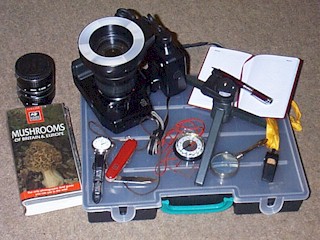
And finally, make sure that everyone has a note of the date, time and venue (and perhaps a map, too).
Maybe that is stating the obvious, but it's a great shame when poor preparation spoil what should have been an enjoyable day in the countryside learning more about fungi and the rest of the natural world.
Important Safety Warning
 Some species of fungi are DEADLY POISONOUS, and edible fungi can easily be confused with poisonous ones if specimens are not thoroughly examined. Extreme care is therefore essential when gathering wild fungi to be used as food. If you are at all uncertain, show the fungi to an expert and obtain positive identification before eating them or giving them to anyone else who might eat them. Some species of fungi are DEADLY POISONOUS, and edible fungi can easily be confused with poisonous ones if specimens are not thoroughly examined. Extreme care is therefore essential when gathering wild fungi to be used as food. If you are at all uncertain, show the fungi to an expert and obtain positive identification before eating them or giving them to anyone else who might eat them.
Guidelines for identifying fungi
- Fungi of a particular species can vary tremendously in size, shape and colours. Before eating any edible fungi, make
positive identification of several specimens.
- Young specimens rarely display the full range of identification features. Do not collect
immature mushrooms that you cannot positively identify.
- Old mushrooms decay rapidly and can become infested with worms and grubs; they are best
left alone.
- The Fungi Identification section of this website lists visual and other
identification features for each species in the guide. The pictures alone are not
sufficient, and it is essential to match up all of the features accurately.
- If a specimen that you find disagrees in even one respect with the details given here, it is
best to assume that the fungus you have found is NOT the one illustrated and described on that page. If in doubt, leave them out.
Disclaimer
The content available on this Web site is for information and interest only, and we do
not guarantee its accuracy or its completeness. Your use of the content for any purpose, including the identificatuion of fungi and selection of edible species, is
entirely at your own risk.
Top of page...
Conservation
Fungus conservation is nowhere near as advanced (nor is is as commonly practised) as botanical conservation; however, some simple guidelines will help ensure that most of the fungi that you find are available for others to enjoy and as food or habitat for the insects and other animals that feed upn them or in some cases live within them!
- Look before you leap - many beautiful fungi nestle in among the
grass or in forest leaf litter, and they can easily be damaged or destroyed by
trampling feet
- Take photographs rather than specimens home except when you need
specimens for study and identification or are collecting wild
mushrooms that you intend to eat
- Collect only those edible fungi you have identified with certainty
- Pick only sufficient common edible mushrooms for your own needs
- Do not disturb leaf litter in the search for immature fungi, or you
are likely to destroy many immature specimens and perhaps kill their
mycelium as well as plants and other creatures that share the same habitat
- Be aware that some very rare fungus species are protected by law and must
not be picked or their habitat disturbed
Where on earth can you tread safely?
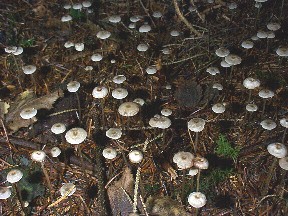
Keeping Notes - guidelines for fungus recording
Each enthusiast or each Fungus Group can develop their own preferred recording system for location and habitat data. This general-purpose record sheet is easily
modified to suit your preferences:
| Date |
Day, month, year |
| Location |
Venue details |
| Situation |
Solitary, group size etc |
| Substrate |
On living/dead wood (type), in moss, leaf
litter, soil |
| Possible mycorrhizal partners |
Nearby trees or shrubs |
| Cap |
Diameter, colour, nature of surface,
odour etc |
| Gills/tubes |
Colour, shape, size, crowded/spaced etc |
| Spore print |
Colour |
| Stem |
Diameter, length, shape, colour, nature
of surface |
| Base |
Rooting, shape, volva etc |
| Other details |
Colour changes, etc |
Fungus Photography
Here are a few tips for
taking pictures of fungi in the wild:
- Try to find undamaged specimens
- If possible, take the picture from the best side in terms of image
composition
- For fungi (other than rare ones - please see our Conservation
Advice above) on soil or leaf litter, you may be able to reposition
specimens to good effect
- Carefully fold back or remove obstacles that would obscure part of
the picture, but retain as natural a foreground and background as
possible
- Use a tripod or other means of avoiding camera shake - a common
cause of poor picture quality
- Focus just behind the front edge of the most important fungus in
your composition
- In close-up photography a small aperture, giving maximum depth of
field, is usually best for pictures intended to help with
identification
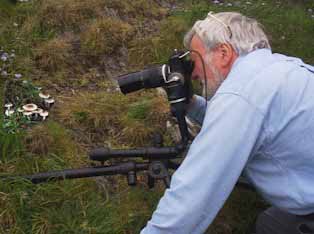
Using a tripod and cable release avoids camera shake and so
permits slow (small-grain) film or digital images with the long exposure and small
aperture settings necessary for good depth of field in natural
daylight conditions.
If your camera does not have a cable release facility, simply use the timer; unlike birds and insects, fungi are not noted for flying away in the few seconds between operating the shutter switch and the timer actuating the shutter itself!
In dark woodlands, often the only alternative to using a tripod and long exposure is to rely on flash photography. Built-in flash usually gives a very 'flat' effect, can cause bleaching of pale areas, and sometimes casts shadows in the lower part of the image. A detachable flash gun, operating from the side rather than directly in front of the subject, can work well, but you may need a reflector to redirect some of the light from the 'dark side' of the subject. All this takes time to set up, of course, and the equipment must be carried; a tripod is often a better solution.
-
Top of page...
Fungi for Food
- A beginners guide to gathering and cooking edible wild mushrooms
-
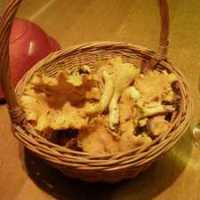
On the subject of wild mushrooms that you can eat we stress, both in our Safety Guide and here in this brief introduction, that just as some plants and trees are poisonous (don't eat the seeds of Deadly Nightshade or of Laburnum, for example) some fungi are also deadly poisonous.
If you plan on gathering mushrooms for food then you really do need to be very careful. Until you are 100% confident about identification, always seek expert help. Joining a fungus group is a very good way of learning how to identify not only some of the finest edible fungi but also, and even more importantly, the imposters that may be poisonous or hallucinogenic.
Take no risks
If in doubt, do not contemplate eating a mushroom, toadstool or any other form of fungus. There are no old incautious fungus foragers: they die young.
A Beginner's Guide to Fungus Foraging
- Get to know how to identify with certainty a small number of good edible fungi
- And even more importantly make sure that you can identify the most deadly of the poisonous ones
- Do not experiment; get expert advice if you are in any doubt
- Do not trust visual identification alone, whether from books or websites (including this one), as fungi vary tremendously in size, shape, colour and sometimes even in growing habitat
- Many edible fungi can cause stomach upsets if they are not thoroughly cooked; only a tiny minority are suitable for eating raw
- Just as people react differently to other kinds of food, so some folk can be upset by eating mushroom species that others enjoy without any problems; so always try a very small portion of a new mushroom species until you know that it suits you
- Remember that wild fungi tend to concentrate heavy metals such ar lead and cadmium, and so eat them only as part of a balanced diet. Relying largely or solely on fungi for food is as unwise as relying solely on slow-growing fish (for example) or any other food sources that accumulate toxins from the eNvironment
- Do not gather fungi (or berries for that matter) from polluted land or from beside busy roads where vehicle exhaust toxins can accumulate
- First Nature cannot accept responsibility for poisoning if you eat any of the species listed as 'edible' on this website; the absence of any mention of toxicity must not be taken as implying that a species is edible.
- That said, a few fungi species are both plentiful (so there is no real conservation concern as long as you take just a few rather than leaving the area bare!) and absolutely delicious. Mushrooms make a wonderful occasional treat.
Our Favourite Edible Mushrooms
We love eating wild mushrooms. We gather them where we live in Wales and we have some delicious mushroom recipes, but for safety's sake we restrict our collecting to those fungi species that are both plentiful and easily identified. Some of our real favourites are:
- Boletus edulis - Penny Bun Bolete, Cep, or Porcini
- Agaricus campestris - Field Mushroom
- Morchella elata and Morchella esculenta - Morels (a great springtime treat)
- Cantharellus cibarius - Summer Chanterelle or Girolle
- Cantharellus tubaeformis - Autumn Chanterelle or Yellow Legs
- Calvatia gigantea - Giant Puffball
- Macrolepiota procera - Parasol Mushroom
There are many other good edible fungi including for example Wood Blewits and Caesar's Mushroom (Amanita caesarea, which we find in southern Europe), and you will find edibility details on the species pages in our Identification Guide.
Fungi in Food Production
Many kinds of mushrooms are edible, and some species are cultivated for sale; however, fungi are crucial in the production of many other kinds of food and drink including cheeses, wine, beer and bread.
Top of page...
Fungus Foray Safety
- How to Avoid Mushroom Poisoning
-
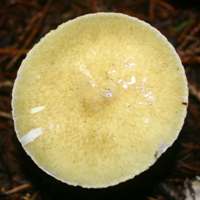
Shown here is the deadly poisonous Amanita phalloides, commonly referred to as the Deathcap, Death Cap or (in the USA) Death Cup. By any name it is a killer. There are several other toxic toadstools and there is no simple way of knowing which fungi are edible mushrooms and which are poisonous (or even hallucinogenic) toadstools. Ignore any suggestions that a cap that peels is safe, or that if animals can eat a fungus it must be safe for humans: these and many other myths have cost people their lives. You just have to be 100% certain in your identification before eating any fungi.
Just as some plants and trees are poisonous (don't eat the seeds of Deadly Nightshade or of Laburnum, for example) some fungi are also deadly poisonous. If you plan on gathering mushrooms for food then you really do need to be very careful. Take no risks: if in doubt, do not contemplate eating a mushroom, toadstool or any other form of fungus.
- Stick to well-known and easily identifiable edible mUshroom species - see our list of 'favourites' below
- Collect only edible Mushrooms - do not combine general fungus forays with gathering fungi to eat
- Check all fungi that you gather and discard any species other than known edible ones that you (or an expert guide with you) can identify with certainty
- Discard any doubtful fungi specimens
- Keep fungi in the fridge (but only for a day or two only!) until you are ready to cook them
Top of page...
Poisonous Mushrooms, Fact and Fantasy:
- Learn How to Avoid the Deadly Killers
-
Here is a shortlist of some of the most deadly toadstools; if you eat them they can kill you unless you get very early professional treatment (sometimes the treatment involves kidney and/or liver transplants!).
- Amanita phalloides - Deathcap - probably the cause of more deaths from eating fungi than all other wild fungi species put together; but that is perhaps because it is such a common species and it can easily be mistaken for a Field Mushroom, Agaricus campestris, or other pale edible species. Get to know this one really well!
- Amanita virosa - Destroying Angel. This causes the same problems as the Death Cap but is less common in Britain; it is very common in colder climes such as Scandinavia.
- Cortinarius Speciossisimus (= Cortinarius rubellus) and Cortinarius orellanus - treat all members of this group as seriously poisonous; some of them are just as deadly as the Deathcap (sometimes written Death Cap). If a cap-and-stem mushroom leaves rusty brown spore deposits, do not even consider eating it.
- Gallerina marginata - another relative of the Cortinarius fungi mentioned above, and just as seriously poisonous.
- Amanita muscaria - Fly Agaric - hallucinogenic and possibly lethal to anyone with a heart or respiratory condition or other major illness.
- Amanita pantherina - Panthercap (sometimes written Panther Cap) - generally considered more seriously toxic that the Fly Agaric (Amanita muscaria), so definitely not one for the lunch menu!
- Inocybe erubescens, commonly known as the Deadly Fibrecap, has been known to cause deaths. Many other fungi in this genus are also poisonous, containing the toxin muscarine in much higher concentrations than occur in Amanita muscaria. All fibrecaps should be avoided when gathering fungi for food.
Only a
small minority of fungi are poisonous, but many of the
best edible mushrooms have toxic look-alikes,
and some species are known to be dangerously hallucinogenic. If you suspect
that someone has eaten even a tiny amount of a poisonous fungus, seek
medical attention immediately, retaining a sample of the fungus
responsible for the poisoning.

Amanita fungi account for more than 90% of fatal poisonings in Europe. Amanita Phalloides, the Deathcap, is mistakenly gathered by people seeking edible mushrooms. The toxins in this fungus can destroy the liver, and
even a single cap is enough to kill an adult. Unfortunately this is a very common woodland species, and on woodland edges immature Deathcap fruitbodies are sometimes mistaken for edible Field Mushrooms, Agaricus campestris.

Amanita pantherina, the Panthercap,
contains the same toxins as Amanita muscaria but in a very variable and sometimes
much higher concentration. This uncommon species is sometimes gathered by people seeking the edible Amanita rubescens, itself rather a dangerous mushroom because it contains toxins that are not destroyed unless the mushrooms are cooked very thoroughly.

-
-
Amanita virosa, the Destroying Angel, is
infrequent in lowland areas but it occurs more often at higher
altitudes. It is mistakenly gathered by collectors of edible Agaricus fungi such as the Field Mushroom, Agaricus campestris.

-
-
Poisoning by Gyromitra esculenta, the
False Morel, can be fatal. The toxins within this impostor are not
all destroyed by cooking, and even when it has been cooked there
are concerns that this fungus may cause cancer. Morels such as Morchella esculenta and Morchella elata have concave cap surfaces rather than contorted brain-like structures making up their caps.
The Good, the Bad and the Fungi
Most wild fungi are not poisonous, but those mentioned above are just a few that cause serious and possibly fatal poisoning. Many other toadstools can cause tummy upsets - sometimes very unpleasant - while others simply taste bad or are too tough to eat.
Imposters - edible fungi with toxic lookalikes
Many edible fungi have lookalikes that are inedible and in some cases even
poisonous. Of these six pairs of fungi, the upper species
is a popular edible mushroom while below is an inedible or even deadly poisonous lookalike.
Hallucinogenic Fungi
Several common fungi, including the so-called 'magic mushrooms' Psilocybe semilanceata (also known as the liberty cap) have hallucinogenic properties and should not be eaten. Here are just a few to beware of:

-
-
Amanita muscaria is a dangerous and
hallucinogenic fungus. Most of the toxic material is contained
in the cap of the mushroom. Toxicity varies greatly between specimens depending on location, age of fruitbody and possibly also the age of the underground mycellium and/or the tree with which is is mycorrhizally associated.. At least one death has been directly
attributed to poisoning by this very common species.

-
-
Psilocybe semilaceata is one of several small fungi in this genus that bring on serious hallucinatory effects if they are eaten. This particular species grows in meadows, often on land that is periodically spread with slurry or where sheep dung has enriched the soil. That, apparently, is not enough to deter some people from tucking in to these tiny toxic toadstools!
Psychoactive Substances in Fungi
Hallucinogenic fungi have been known about and used, particularly in rites and religious ceremonies, for more than 3000 years. Nowadays more is understood about which fungi species are hallucinogens and the chemical substances they contain that cause psychoactive effects if ingested. The two most commonly used groups of fungi are:
- Those containing ibotenic acid and muscimol - for example Amanita muscaria, the Fly Agaric, Amanita gemmata, the Jewelled Amanita, and Amanita pantherina, the Panthercap. The active substances in these fungi that cause hallucinatory effects are quite different from the poisonous chemicals contained in their close relatives Amanita phalloides, the Deathcap and Amanita virosa, the Destroying Angel. Some of the fungi traditionally sought for their psychoactive effects may also contain deadly toxins although in low concentrations such that it is unlikely anyone would consume a sufficient quantity at one sitting to cause death by poisoning. (The toxins in some fungi are now known to accumulate in the human body, however, so over a period of months or years it is still possible to consume a seriously damaging or even lethal dose.)
- Those containing Psilocybin and Psylocin - for example Panaeolus foenisecii, Psilocybe semilanceata and Gymnopilus junonius. In structure these chemicals are similar to lysergic acid diethylamide, or LSD, a derivative of the fungus Claviceps purpurea, common known as Ergot, that infects grasses and most particularly rye grain.
Top of page...
Safety First
Individual people react differently to several kinds of fungi.
What to one person may act as a mild stimulant can have far more serious effects on others. Hallucinogenic fungi are toxic, and some species can cause lasting damage.
Mischievous Myths that can cost lives:
Poisonous mushrooms are brightly coloured; edible ones are pale or dull.
Chanterelles and Caesar’s Mushrooms prove that this is untrue.
Toxic toadstools smell bad and taste bad.
No! Deathcap, the world’s most poisonous mushroom, is reputed to taste nice.
If you can peel a mushroom it’s okay to eat it.
Not so: some deadly poisonous species can be peeled.
If slugs and other creatures can eat them it’s fine for humans to eat them too.
Toxins can be harmless to other creatures but deadly for humans.
Poisonous mushrooms will turn black if touched by a silver spoon (or, some say, vice versa).
There is not truth in this tale… either way round!
Cooking destroys the toxins in poisonous mushrooms.
The most deadly toadstool toxins are unaffected by the cooking process.
Mushroom Cookbooks
If you do gather some of the wild fungi that are recommended for eating, a good mushroom cookery book can help you make them into an appetising meal. Authors' names to look out for include Antonio Carlucci, John Wright, and Roger Phillips. Or for edible mushrooms found in England, Wales, Scotland and Ireland you might like to try one of the recipes from this website...
Top of page... |